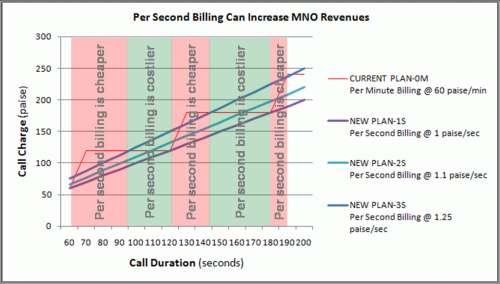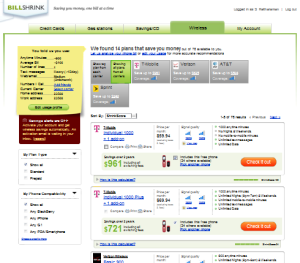Part-1 of this blog post explained how per second billing does not portend financial ruin for mobile network operators. It pointed out that, depending on whether MNOs apply their per minute tariff to bill on a per second basis or not, call charges may or may not reduce.
This Part-2 weighs in on the various options available to MNOs by which they can not only prevent a fall in their revenues but can actually harness per second billing to drive the next level of revenues while simultaneously providing greater choice to their subscribers.
In case MNOs apply their existing per minute tariffs to bill on a per second basis, call charges will reduce for call durations exceeding one minute. However, this doesn’t have to mean a drop in their revenues: MNOs could use the lower charges to bolster market penetration and add more subscribers – just as they’ve done in the past. Despite slashing per minute rates from around INR 16 to less than a rupee in the last 15 years, many MNOs became multibillion dollar corporations by increasing their subscriber base from a few tens of thousands in 1995 to around 450 million now.
On the other hand, in case MNOs feel that the Indian mobile phone market is nearing saturation, they might conclude that a lower tariff wouldn’t result in an expansion of the market. In that case, they can turn to their peers in other mature markets and find ways to protect and grow their revenues. Let’s look at a few possibilities.
Most regulators, including India’s TRAI, don’t mandate any specific tariff, so MNOs are free to hike their per minute charge – like many have done abroad. According to one report, “subscribers would now be charged for actual airtime utilised at a higher rate. This compares to the per-minute billing system, where subscribers are being charged for unused seconds in a minute, resulting in some level of subsidisation of the rate, [that is, more seconds billed at a higher rate]”. Under this option, MNOs could bump up their tariff from the current (say) 60 paise per minute to (say) 70 paise per minute and protect their revenues, albeit forcing customers to shell out more for their mobile phone usage.
If MNOs don’t wish to do this, they still have the option of introducing new tariff plans on a per second basis. Let’s take a few examples of alternative per second tariff plans. The most intuitive plan (say, PLAN-1S) would carry a per second charge of 1 paisa, the figure derived by simply prorating the present charge of 60 paise per minute (say, PLAN-0M).
What is not obvious and hasn’t found any mention in all the media reports I’ve come across is that MNOs can very well come up with other plans with a higher cost per second viz. PLAN-2S (1.1 paise per second) and PLAN-3S (1.25 paise per second), to quote two examples. This is not as far-fetched as it sounds for there are several precedents from MNOs abroad for such differentiated tariffs. To quote from this report, “be aware that per second billing rates are higher than packages charged at per minute rates!”. For the sake of simplicity, we’re avoiding variations in the fixed monthly fees between these plans, although that’s not so uncommon in practice.
When we compute call charges for a range of call durations according to each of the above tariff plans, we notice that per second billing is not always cheaper than per minute billing. As you can see from the following chart, short calls will be cheaper with per second billing whereas chattier callers might be better off staying with their present per minute tariff and billing plans.

(Click here to download the Excel-based mobile phone call charge calculator.)
Therefore, it’s evident that call charges – and MNO revenues – depend more upon how long calls are and how tariff plans are structured, so per second billing does not automatically mean drastic drop in MNO revenues.
 Going forward, MNOs in India will likely follow their overseas brethren and come up with different plans with varying tariffs for different pulse rates and leave it to the customer to decide what’s best for him / her depending upon on his / her individual usage pattern. We’re familiar with per minute billing and are now coming to terms with the per second paradigm. Going forward, we might encounter ‘per 6 second billing’ and ‘per 30 second billing’, which are two other pulsing rates that have been used abroad. When that happens, selecting a mobile phone plan can become very complex and subscribers might need call charge calculators and comparison shopping websites like BillShrink (USA), MoneySuperMarket (UK) or BilligerTelefonieren (Germany) to try out various options and select the most cost-effective plans for themselves.
Going forward, MNOs in India will likely follow their overseas brethren and come up with different plans with varying tariffs for different pulse rates and leave it to the customer to decide what’s best for him / her depending upon on his / her individual usage pattern. We’re familiar with per minute billing and are now coming to terms with the per second paradigm. Going forward, we might encounter ‘per 6 second billing’ and ‘per 30 second billing’, which are two other pulsing rates that have been used abroad. When that happens, selecting a mobile phone plan can become very complex and subscribers might need call charge calculators and comparison shopping websites like BillShrink (USA), MoneySuperMarket (UK) or BilligerTelefonieren (Germany) to try out various options and select the most cost-effective plans for themselves.
Pingback: How Mobile Network Operators Can Use Mobile Apps To Boost ARPU | GTM360 Blog